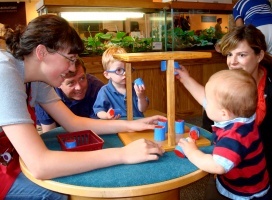
What is "Living Laboratory"?
Living Laboratory® aims to educate the public about child development by immersing museum visitors in the process of scientific discovery. Since 2005, Living Laboratory at the Museum of Science has connected the public with child development research by collaborating with local research institutions - including Harvard University, Boston College, Tufts University, Northeastern University, Boston University, Children's Hospital and others. The program was developed in the Discovery Center, and receives support from the National Science Foundation.
In the Living Laboratory’s educational model, scientists (in disciplines including developmental psychology, cognitive science, educational psychology, cognitive neuroscience, social psychology and related fields) recruit participants and conduct their studies within dynamic exhibits at their local museum, rather than behind closed doors. Families visiting the museum are invited to participate in on-going research projects (on topics including math and language cognition, causal learning, emotion recognition, and social reasoning), and to engage in one-on-one conversations with the scientists. Collaborating scientists work closely with informal science educators to communicate the questions and methods of their work to parents and other caregivers via informal conversations and hands-on activities that illustrate recent child development research.
The National Science Foundation's "Science Nation" series captured Living Laboratory in action at the Museum of Science, Boston:
What is the National Living Laboratory initiative?
The Living Laboratory model was developed at the Museum of Science in Boston, with support from the National Science Foundation. The purpose of the National Living Laboratory initiative is to assist researchers and informal science educators in collaboration efforts that foster public awareness, engagement and understanding of the scientific study of children’s learning and development.
The Maryland Science Center, the Madison Children's Museum and the Oregon Museum of Science & Industry have adapted and implemented the Living Laboratory model in their own early childhood exhibitions and serve as National Living Laboratory “Hub Sites,” disseminating information and resources about the model to other museums and academic institutions nation-wide. There are more than thirty active Living Laboratory sites across the United States.
Interested professionals can create an account, and log in to connect with the hub leader in their region and access a variety of resources for developing a program in the Living Laboratory® model.
Essential Elements - the Living Laboratory® Model
Goals for Public Audiences
Positive Educational Experiences with Research that are Accessible to any Visitor
- Visitors engage in conversations, with researchers and/or museum educators, to learn about scientific research
- Visitor education focuses on the process of science, increasing interest in and understanding of research questions and research methods, as well as study results
- Visitors contribute to the process of scientific discovery through participation in active studies
- Non-participant visitors talk with researchers and learn about on-going studies in ways similar to study participants
- Studies occur in plain-view of the public, on the exhibit floor (not behind closed doors)
Goals for Professional Audiences
Mutual Professional Development Among Researchers and Educators
- Researchers and museum educators share their respective expertise in order to strengthen cross-disciplinary practice in communicating science with public audiences
- Museum educators and researchers communicate regularly, collaboratively monitoring the program to ensure scientific and educational goals are met, and facilitating negotiation of logistical and financial needs.
- On-site research is an expected and predictable presence in the museum